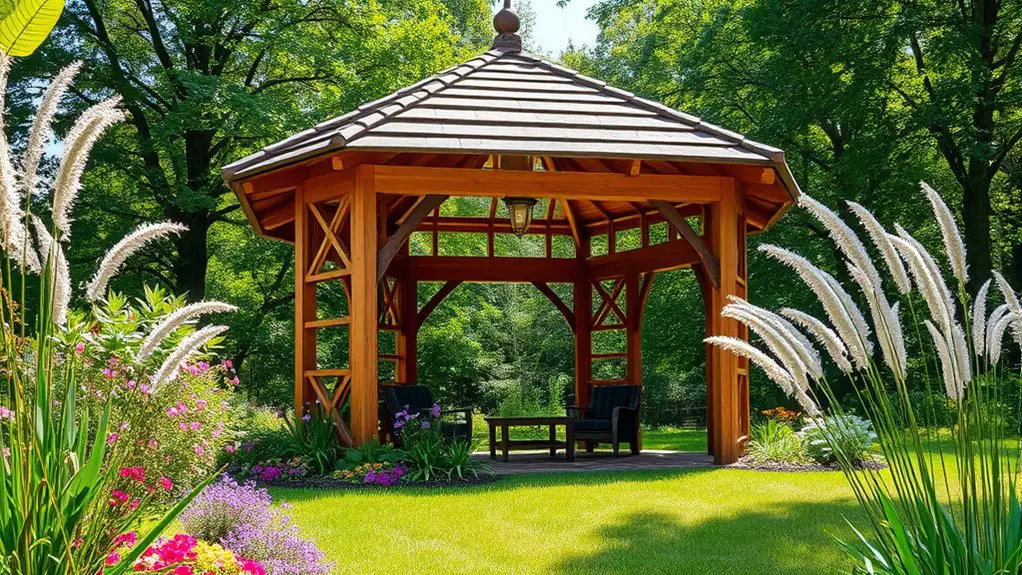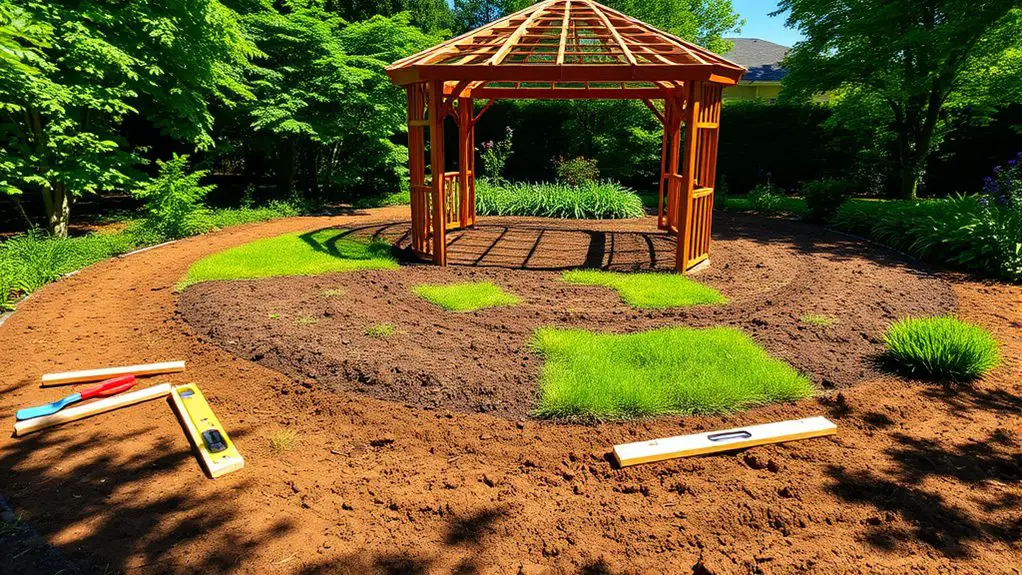To build a gazebo without a foundation, first, choose a level, well-draining location that offers both privacy and desired sun exposure. Prepare the ground by clearing debris and leveling the surface. Select durable materials like cedar or treated wood for longevity, and guarantee the design complements your space. Assemble the frame using interlocking joints and secure it with heavy-duty anchors. Finally, enhance your gazebo with decorative elements and functional accessories to create a cozy retreat. By following these steps, you’ll find the process easier than expected.
Choosing the Right Location for Your Gazebo

When you’re ready to build your gazebo, choosing the right location is essential, as it can influence both the structure’s longevity and your enjoyment of the space. Start with a thorough site assessment; look for level ground that drains well to avoid water pooling. Consider the surrounding landscape—are there trees nearby? While they can provide shade, falling branches or excessive leaf litter might pose a risk.
Next, think about sun exposure. Do you want a sun-drenched retreat or a cool hideaway? Position your gazebo to capture the ideal amount of sunlight throughout the day, enhancing your experience on warm afternoons. Also, consider privacy; placing it away from prying eyes can create a personal oasis. Finally, guarantee adequate access to utilities if you plan to incorporate lighting or fans. This careful planning will not only give you freedom in your design but also maximize your enjoyment for years to come. Additionally, ideal placement should be on flat, sturdy ground to ensure stability and enhance your overall experience.
Selecting Materials for a Foundation-Free Structure
After you’ve pinpointed the perfect location for your gazebo, the next step involves selecting materials that can support a foundation-free design. You’ll want to prioritize material durability, as your gazebo will face various weather conditions. Opt for high-quality wood, such as cedar or redwood, which naturally resist decay and insects. For the roofing, consider durable metal or composite materials that won’t warp or leak over time.
Additionally, make certain you choose materials with suitable weight distribution properties. A lightweight structure can help prevent sinking or shifting, so think about using aluminum for railings or lightweight synthetic materials for decorative elements. When assembling, use brackets and connectors designed to enhance stability without a concrete foundation. This meticulous approach not only guarantees your gazebo’s longevity but also embraces the freedom of a naturally integrated outdoor space, harmonizing with its surroundings. Moreover, understanding the importance of a foundation can help you make informed choices about your gazebo’s design and stability.
Designing Your Gazebo: Style and Functionality

When designing your gazebo, you’ll want to balance aesthetic appeal with practical use. Consider the style that complements your landscape while ensuring a functional layout that meets your needs, from seating arrangements to accessibility. Selecting the right materials will not only enhance durability but also elevate the overall design, making your gazebo a true centerpiece. Additionally, incorporating essential features like lighting and seating can significantly enhance the functionality and comfort of your gazebo.
Choosing the Right Style
Choosing the right style for your gazebo can greatly enhance both its aesthetic appeal and functionality, ensuring it complements your outdoor space perfectly. Consider traditional styles, like Victorian or Colonial, which evoke charm and nostalgia, making them ideal for gardens or classic homes. On the other hand, modern designs often feature sleek lines, open spaces, and minimalist elements, creating a contemporary vibe that suits urban settings. When selecting, think about how the structure’s style aligns with your personal taste and the surrounding environment. The right choice will not only elevate your landscape but also provide a welcoming space for relaxation and gatherings. Ultimately, it’s about embracing your freedom to create a sanctuary that reflects your lifestyle and vision.
Functional Layout Considerations
The style of your gazebo sets the stage, but the functional layout determines how well it serves your needs. Consider your desired activities—whether it’s hosting gatherings or enjoying quiet moments. Your design should prioritize functional space, ensuring that seating, pathways, and features like tables or fire pits are thoughtfully arranged. Aim for a seamless user flow; this means positioning elements to facilitate easy movement and interaction. Think about how many people you’ll host and the types of furniture that will enhance your experience. Remember to include adequate space for accessibility, allowing everyone to navigate freely. By blending aesthetics with practicality, you create an inviting retreat that caters to both relaxation and socialization, embodying your vision of freedom.
Material Selection Tips
Material selection plays an essential role in designing a gazebo that harmonizes style and functionality. You’ll want to balance material durability with cost efficiency to create a structure that lasts and fits your budget. Consider using materials like treated wood for aesthetics and longevity, or metal for a modern touch.
Here’s a quick comparison of popular materials:
| Material | Durability | Cost Efficiency |
|---|---|---|
| Treated Wood | High | Moderate |
| Metal | Very High | High |
| Vinyl | Moderate | High |
| Composite | High | Moderate |
Choosing the right material can elevate your gazebo’s design while ensuring it stands the test of time, allowing you to enjoy your outdoor space freely.
Preparing the Ground for Your Gazebo

Creating a solid base for your gazebo starts with proper ground preparation. First, assess your chosen location for soil stability; you want firm, well-draining soil that can support your structure. Clear away any debris, rocks, or vegetation to expose the bare ground. Next, focus on ground leveling; use a rake to create an even surface, ensuring there are no high or low spots that could compromise your gazebo’s integrity. If your area has uneven terrain, consider using soil or sand to fill in depressions. Compact the soil to enhance stability, as loose ground can lead to movement over time. Finally, mark the corners of your gazebo to maintain alignment during assembly. Taking these steps will provide a strong foundation, allowing you to enjoy your new outdoor haven without the worry of structural issues. With the right preparation, your gazebo can become a true extension of your freedom and creativity. Additionally, be mindful of sun and shade exposure to ensure a comfortable environment throughout the day.
Assembling the Gazebo Frame Without a Foundation
Begin by carefully assembling the gazebo frame, ensuring each component fits securely without the need for a traditional foundation. Use frame assembly techniques that focus on interlocking joints, which provide stability while allowing flexibility. Start with the base, laying out the horizontal beams on level ground.
You’ll need a few essential tools: a power drill, screws, a level, and a measuring tape. These will help you achieve precise measurements and secure connections. After establishing the base, erect the vertical posts, ensuring they’re plumb and evenly spaced.
Next, attach the rafters, placing them at equal intervals to distribute weight evenly. This method not only enhances the aesthetic appeal but also reinforces structural integrity. Remember, working without a foundation means you must prioritize a solid, well-constructed frame to withstand elements. For added stability, use proper anchoring techniques to secure your gazebo against strong winds. Enjoy the creative freedom of building your gazebo, combining functionality with your personal style.
Securing Your Gazebo Against Wind and Weather
When it comes to securing your gazebo against wind and weather, you’ll want to focus on three key areas: anchoring, bracing, and protective coverings. Ensuring your gazebo stands tall against the elements involves a strategic approach that balances aesthetics with functionality. Here are four essential steps to enhance wind resistance and durability:
To protect your gazebo from wind and weather, prioritize anchoring, bracing, and durable coverings for optimal longevity.
- Use Heavy-Duty Anchors: Opt for ground anchors or stakes to tether your gazebo firmly to the earth.
- Incorporate Cross Bracing: Install diagonal supports within the frame to distribute wind loads evenly.
- Select Weatherproof Materials: Choose treated wood or metal that withstands moisture and UV damage.
- Install a Durable Roof Cover: A high-quality tarp or metal roofing can shield against rain and strong winds, offering lasting protection. Additionally, consider using anchoring techniques to further stabilize your gazebo against extreme weather conditions.
Enhancing Your Gazebo With Decor and Accessories
Now that your gazebo is secure, it’s time to transform it into a cozy retreat. Consider adding ambient lighting, like string lights or lanterns, to create a warm atmosphere, while selecting furniture that balances comfort and style. Don’t forget to accessorize with cushions, rugs, and small decorative items that reflect your personal taste, making the space truly inviting. Incorporating low-maintenance plants can enhance the natural beauty and create a relaxing atmosphere in your gazebo.
Lighting Options for Ambiance
How can you transform your gazebo into an enchanting retreat as the sun sets? The right lighting can create a magical ambiance, perfect for winding down or entertaining guests. Consider these options:
- String Lights: Drape them across the structure for a warm, inviting glow.
- Lantern Options: Use decorative lanterns, hung or placed on tables, to add character and charm.
- Solar Fixtures: Position solar-powered lights to illuminate pathways or accentuate your gazebo’s features without wiring hassles.
- Candle Accents: Incorporate candles in jars or holders for a soft flicker, enhancing the romantic vibe.
Furniture and Accessories Ideas
As the evening light softens, the right furniture and accessories can elevate your gazebo into a cozy haven. Consider mixing furniture styles—perhaps a rustic wooden table paired with modern metal chairs for an eclectic vibe. Opt for weather-resistant fabrics for cushions, ensuring comfort while embracing nature.
Accessorize with string lights or lanterns to create a warm glow, and don’t forget a vibrant area rug to define the space. Potted plants or hanging planters can add a touch of greenery, enhancing the atmosphere. For entertainment, think about a compact bar cart or a small fire pit. These accessory options not only enhance aesthetics but also invite relaxation and enjoyment, making your gazebo an inviting retreat for all.
Frequently Asked Questions
Can I Build a Gazebo on Sloped Ground Without a Foundation?
Ever wondered if you can build a gazebo on sloped ground? With innovative building techniques and slope stabilization methods, you can create a sturdy structure that embraces nature while maintaining stability, giving you the freedom to enjoy your space.
How Do I Ensure Proper Drainage for a Foundation-Free Gazebo?
To guarantee proper drainage for your gazebo, consider various drainage solutions like French drains or gravel beds. Effective water management techniques will prevent pooling, allowing you to enjoy your space without concerns about water damage.
What Tools Do I Need for Building a Gazebo Without a Foundation?
You’ll need tool essentials like a saw, drill, and level, along with sturdy building materials such as treated wood and brackets. These will guarantee your gazebo stands strong, embracing freedom while enhancing your outdoor space.
Are There Any Local Regulations for Building a Gazebo Without a Foundation?
Before starting your gazebo, check local permits and zoning laws. They can vary widely, and understanding these regulations helps guarantee your project stays compliant, letting you enjoy your creative freedom without unwanted legal complications later.
How Can I Maintain My Gazebo Without a Foundation Over Time?
Like caring for a beloved garden, maintaining your gazebo requires regular inspections and seasonal maintenance. Check for rot, secure loose fittings, and clean debris to guarantee its beauty and safety endure through the years.

